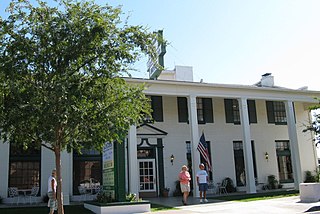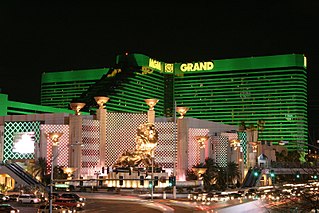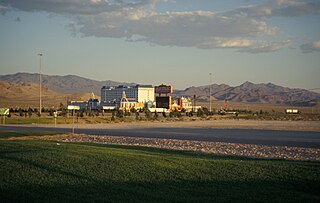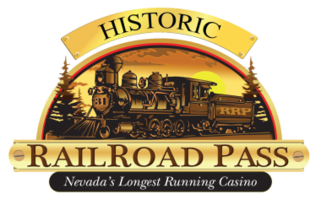
Boulder City is a city in Clark County, Nevada, United States. It is approximately 26 miles (42 km) southeast of Las Vegas. As of the 2020 census, the population of Boulder City was 14,885. The city took its name from Boulder Canyon. Boulder City is one of only two places in Nevada that prohibits gambling, the other being the town of Panaca.

MGM Resorts International is an American global hospitality and entertainment company operating destination resorts in Las Vegas, Massachusetts, Michigan, Mississippi, Maryland, Ohio, and New Jersey, including Bellagio, Mandalay Bay, MGM Grand, and Park MGM.
Mirage Resorts was an American company that owned and operated hotel-casinos. It was acquired by MGM Grand, Inc. in 2000, forming MGM Mirage.

Lake Mead is a reservoir formed by the Hoover Dam on the Colorado River in the Southwestern United States. It is located in the states of Nevada and Arizona, 24 mi (39 km) east of Las Vegas. It is the largest reservoir in the US in terms of water capacity. Lake Mead provides water to the states of Arizona, California, and Nevada as well as some of Mexico, providing sustenance to nearly 20 million people and large areas of farmland.

The Las Vegas Valley is a major metropolitan area in the southern part of the U.S. state of Nevada, and the second largest in the Southwestern United States. The state's largest urban agglomeration, the Las Vegas Metropolitan Statistical Area is coextensive since 2003 with Clark County, Nevada. The Valley is largely defined by the Las Vegas Valley landform, a 600 sq mi (1,600 km2) basin area surrounded by mountains to the north, south, east and west of the metropolitan area. The Valley is home to the three largest incorporated cities in Nevada: Las Vegas, Henderson and North Las Vegas. Eleven unincorporated towns governed by the Clark County government are part of the Las Vegas Township and constitute the largest community in the state of Nevada.

Mandalay Resort Group was an American hotel and casino operator based in Paradise, Nevada. Its major properties included Mandalay Bay, Luxor, Excalibur and Circus Circus, as well as half of the Monte Carlo. In terms of market capitalization, it was one of the largest casino operators in the world. Its stock traded on the New York Stock Exchange with the ticker symbol "CIR" and "MBG".
The Hacienda was a hotel and casino on the Las Vegas Strip in Paradise, Nevada, that operated from 1956 to 1996. It was opened by Warren Bayley, who owned other Hacienda properties in California as well. Bayley opened the hotel portion in June 1956, although the opening of the casino was delayed as the Nevada Gaming Control Board objected to his choice of casino manager, Jake Kozloff. The casino portion eventually opened on October 17, 1956. The $6 million property had 266 rooms and the largest pool on the Las Vegas Strip. Like its sister properties in California, the resort included a neon sign that depicted a cowboy riding a palomino horse.
The settlement of Las Vegas, Nevada was founded in 1905 after the opening of a railroad that linked Los Angeles and Salt Lake City. The stopover attracted some farmers to the area, and fresh water was piped in to the settlement. In 1911, the town was incorporated as part of the newly founded Clark County. Urbanization took off in 1931 when work started on the Boulder Dam, bringing a huge influx of young male workers, for whom theaters and casinos were built, largely by the Mafia. Electricity from the dam also enabled the building of many new hotels along the Strip. The arrival of Howard Hughes in 1966 did much to offset mob influence and helped turn Las Vegas into more of a family tourist center, now classified as a Mega resort.

Lake Las Vegas is a 320-acre (130 ha) reservoir in Henderson, Nevada with a 3,592-acre (1,454 ha) developed area around it. The area is sometimes referred to as the Lake Las Vegas Resort. It is being developed by 5 companies including Lake at Las Vegas Joint Venture LLC.

The Wild Wild West Gambling Hall & Hotel was a hotel and casino in Paradise, Nevada, near the Las Vegas Strip. It was owned and operated by Station Casinos. While the casino and adjoining 260-room hotel were relatively small, the site is over 58 acres (23 ha) in size.

A locals casino is a casino designed primarily to attract residents of the area in which it was built rather than tourists or vacationers. The term is most commonly associated with casinos in Nevada, United States, to distinguish them from casinos that target mostly tourists in a central area. Locals casinos tend to operate under slightly different business models than those frequented by tourists, most notably having lower house advantages.

Nevada Landing was a hotel and casino designed to resemble two riverboats. It was located in Jean, Nevada, United States, near the California state line, within a quarter mile of Interstate 15. The hotel, owned by MGM Resorts International, had 303 hotel rooms, four restaurants, over 800 slot machines, live keno, table games, banquet facilities, and wedding services. The property was typically marketed with its sister hotel, the Gold Strike Hotel and Gambling Hall, still located across the I-15 freeway.

Terrible's Hotel & Casino, formerly the Gold Strike Hotel and Gambling Hall, is a defunct casino hotel in Jean, Nevada, approximately 13 mi (21 km) north of the California state line, and about 32 miles (51 km) south of Downtown Las Vegas. It opened in 1987, and closed in 2020. It was owned and operated by JETT Gaming from 2015 until its closure. It had 811 rooms, several restaurants, and 40,006 square feet (3,716.7 m2) of gaming space. The property is planned to be demolished and replaced with an industrial park.
Gold Strike Tunica is a casino hotel in Tunica Resorts, Mississippi, 20 minutes south of Memphis, Tennessee. It is owned by Vici Properties and operated by Cherokee Nation Businesses.
Golden Entertainment, Inc. is an American gaming company based in Enterprise, Nevada that operates casinos, taverns and slot routes. It was formed in 2015 by the merger of Golden Gaming and Lakes Entertainment. It is the largest tavern operator and largest slot route operator in Nevada. In October 2017, the company completed an $850 million acquisition of American Casino & Entertainment Properties. The company now has eight casino resorts, all located in Southern Nevada.
A hacienda is an estate in Spain and the former Spanish Empire.

Railroad Pass Hotel & Casino, named after nearby Railroad Pass, is a hotel and casino located in Henderson, Nevada.
Gold Strike Resorts was a family of gaming companies based in Jean, Nevada.

Richard Craig Estey is an American businessman, political donor and philanthropist. He is the founder and chairman of Nevada Restaurant Services, Inc. parent company to Dotty's, Bourbon Street, Hoover Dam Lodge, Laughlin River Lodge, La Villita, and Red Dragon an enterprise of taverns, hotels, and casinos with locations in Nevada and Montana. Nevada Restaurant Services, Inc. maintains the largest slot route in Nevada.














